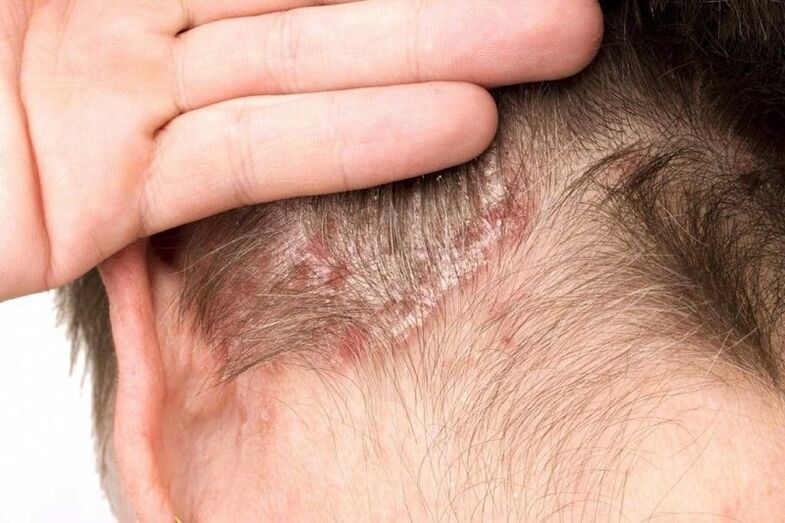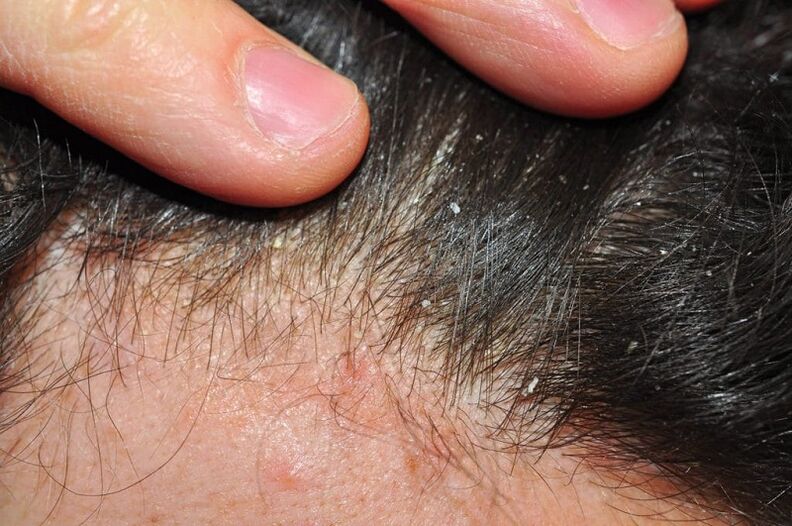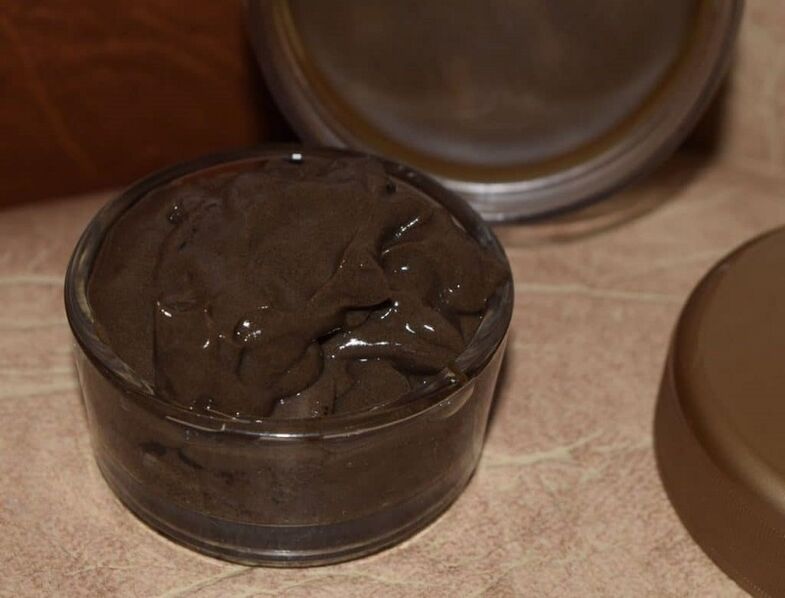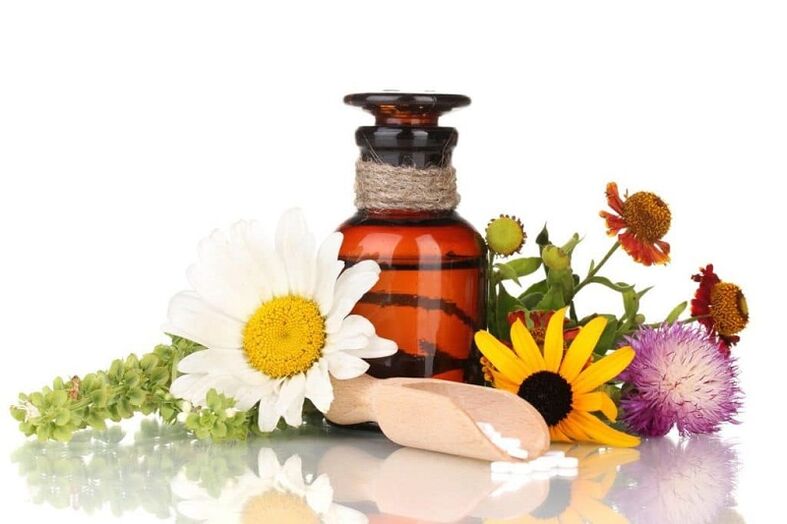Psoriasis is a chronic inflammatory disease of the epidermis. The pathology is not contagious because it is caused by an autoimmune disease, not an infectious cause. The disease is characterized by excessive division of skin cells, which leads to the formation of dense plaques. Inflammation affects any part of the body. Scalp psoriasis is a fairly common form of the disease. The peculiarity of the localization of the initial rash is the complexity of treatment. This form of psoriasis often leads to the development of complexes and self-dissatisfaction because it is visible to others. Elements of the rash do not look aesthetically pleasing and require timely treatment.
Causes of the disease
Scalp psoriasis develops for the same reasons as skin lesions on the body. Factors that contribute to the formation of plaques on the skin may include:
- stress;
- seborrhea;
- prolonged exposure to the sun;
- allergic reaction;
- skin damage;
- decrease in immunity.

Stress aggravates many diseases, including psoriasis.
Regardless of the reasons for the development of the first episode of the disease, psoriasis is always accompanied by excessive division of epidermal cells, which explains the appearance of rash elements. This is due to the body's autoimmune reaction, which triggers an immune attack on the skin cells.
The disease is characterized by a wavy course with periods of exacerbation and remission. Doctors often call the pathology a psychosomatic disease because exacerbations of psoriasis are directly related to the patient's psychoemotional state.
Stress, lack of sleep, fatigue, vitamin deficiency in the body can cause an extraordinary inflammation and the appearance of new elements of the rash.
Despite the repulsive appearance of the rash, psoriasis is generally not contagious because it is the result of internal diseases, but not infections or viruses.
Although doctors have not yet determined the exact cause of the disease, most people tend to believe that psoriasis is the result of hormonal imbalances, nervous system instability, and systemic disorders of the body's metabolic processes. , nutrition and a cold climate.
Psoriasis symptoms
Psoriasis in the head begins with the appearance of dense nodules that are not visible. Over time, the knots join together to form islands. The skin around the rash elements becomes swollen and inflamed, dry crusts and scaly areas may appear.
Over time, the nodules become dense and flat, beginning with the formation of large scales of bran-like shape and structure on the peeling surface.
Scalp psoriasis is most often localized in the temporal region, behind the ears, on the neck and along the hairline. Often, peeling and plaques occur along the separation.
The disease can manifest itself at any age. Often, the first episode of psoriasis occurs either during adolescence, or before the age of 20, or over the age of 35.
Scalp psoriasis is classified according to the severity of symptoms. The mild form of the disease is characterized by isolated inflammatory foci and moderate desquamation. Rash in this form is not surprising and responds well to drug treatment.
For a severe psoriasis course on the head, a photograph allows you to assess the severity of the symptoms, which are characteristic of the entire head, hair growth zone, and back of the neck. The elements of the spill are large, the scales are very large and visible to the naked eye.

Scalp psoriasis can affect both the scalp and the surrounding skin.
Timely diagnosis plays an important role in psoriasis of the scalp. An experienced dermatologist will now make a diagnosis during an external examination of the patient. The problem is that many patients do not see a doctor, do not know what psoriasis looks like on the scalp, and make mistakes like dandruff. It is important to remember that psoriasis in the early stages responds well enough to treatment, but the lack of timely therapy will inevitably lead to the development of the disease and damage to more and more parts of the skin.
If you find the first signs of damage to the scalp, you should consult a doctor, because if psoriasis is diagnosed, treatment should be comprehensive and timely.
Stages of the disease
Regardless of the localization of the rash, psoriasis of the scalp and body always lasts in several stages. The first stage is the exacerbation of the disease. During this period, new papules appear on the skin, excessive division of epidermal cells is noted. Papules attach to large lesions, then turn into plaques, which, in turn, begin to peel. The duration of exacerbation depends on a number of factors and can last up to several months. During this period, the rash elements cover the scalp, the epidermis around the ears and around the neck, and can fall backwards. Scalp psoriasis is often accompanied by focal lesions on the skin of the body.
The second stage of the disease is inpatient. During this period, the development of the disease stops, the number of rash elements does not change, the disease does not spread to healthy areas of the skin. At the stationary stage, literally nothing happens - the boards do not increase in size, but they do not decrease. Peeling remains the same, the epidermis looks tight and inflamed. This stage can take several months.
The next step is to reduce the disease. During this period, the inflammatory process is reduced, peeling stops, because the division of epidermal cells stops. The boards gradually soften, shrink in size, and then disappear completely. With proper skin care, not a trace remains after recovery, and in most cases, areas of pigmentation are formed at the site of plaque.
Then comes remission, where the skin looks completely healthy. The duration of remission depends on the patient's lifestyle and general health. It does not last forever, because it decreases temporarily. Subsequent exacerbations can occur over months or years due to stress, climate change, or decreased immunity. With subsequent exacerbation, psoriasis progresses in several stages, beginning with the appearance of new papules, which again end with a decrease in the size of the plaques and complete regeneration of the skin.

In mild forms, psoriasis can be easily mixed with dandruff.
Diagnosis of the disease
Psoriatic rashes on the head can appear in both adults and children, because psoriasis is not uncommon in a child. It is important to detect the onset of the pathological process in time and consult a dermatologist.
Shaving is used to diagnose the disease. The affected epidermis reacts to local damage with a number of specific symptoms that are unique to psoriasis.
When shaved, the scales shed dandruff without causing pain, itching or discomfort. As a result of prolonged exposure and cleaning of the plaque from keratinized particles, a thin skin film is found under the scales. It becomes inflamed, bright pink in color and glows like a stain of stearin. If this film is damaged, small drops of blood appear on the surface of the plaque, indicating damage to the capillaries that are very close to the skin.
This reaction of the epidermis is known as the "psoriatic triad" and is a characteristic symptom of this disease, which allows accurate diagnosis without laboratory diseases.
The principle of treatment
The dermatologist will talk in detail about how to treat psoriasis on the head. The truth is that everyone's disease manifests itself in its own way, so there is no universal treatment regimen for all patients without exception.
The goal of psoriasis therapy is to stop the disease from developing, improve the appearance of the skin, and achieve lasting remission. As the experience of doctors shows, a well-chosen treatment regimen allows you to forget about the disease for several years.
An integrated approach to the treatment of psoriasis is used, which includes:
- use of hormonal ointments to eliminate inflammation;
- use of non-hormonal medications to relieve symptoms;
- physiotherapy to accelerate skin regeneration;
- dietary changes and spa procedures.
The basis of treatment is drugs applied to inflammatory foci for external use. In some cases, it is increased by taking pills for psoriasis at the beginning of treatment, immunostimulatory drugs and vitamin supplements are preferred.

It is impossible to treat psoriasis, but it is quite possible to get rid of its manifestations for a long time
Conservative therapy
Traditionally, dermatologists prescribe two types of skin treatments - non-hormonal ointments and glucocorticoids.
Glucocorticoid ointments are used in short courses during the exacerbation of the disease. Helps to stop inflammation and reduce the rate of disease progression, which allows the inflammation to stop quickly. However, these drugs are not safe. It penetrates the general bloodstream and has a systemic effect on the body, causing disorders of the liver, kidneys and adrenal glands. Hormonal ointments are selected only by a dermatologist. Today, many doctors avoid the use of glucocorticoids in the treatment of psoriasis and note its short-term effects.
The main lines of the fight against the disease are physiotherapy, non-hormonal ointments and lifestyle changes.
Non-hormonal drugs are divided into several groups:
- preparations with naphthalene and solidol;
- resin ointments;
- preparations with sulfur;
- zinc-based creams.
Such ointments have keratolytic properties, ie they help to erode keratinized particles of the epidermis. Not all ointments have a systemic effect on the body and have an oily base, so they soften the plaque quickly.
Ointment based on maple and charcoal resin is recommended for patients with oily scalp. Such funds stop the inflammatory process and increase local immunity, preventing cell division in the affected area.
Ointments containing naphthalene and shea butter are used for very dry boards with a large number of detachable scales. Their main purpose is to prevent the spread of the pathological process to healthy skin. Effectively softens affected areas & improves the overall appearance of the epidermis while providing anti-inflammatory effects
Zinc preparations exfoliate the skin and protect against secondary infections. They are used in all kinds of scalp psoriasis because they move quickly and delicately. Sulfur resin ointment, ointment with sulfur and zinc - these drugs are suitable for most patients and have a therapeutic effect, which is quickly detected.
The advantages of non-hormonal drugs are their natural composition, the absence of contraindications and side effects. Such drugs can be used to treat even small children, because they do not have a systemic effect on the body.

The advantage of natural ointments is harmless
The average course of treatment is 20 days, the ointment is applied three times a day. The disadvantage of treating the scalp with ointment is the untidy appearance of the hair, because all drugs are oily and quickly stain the hair. An alternative is special medicated shampoos, but experience has shown that the best therapeutic effect is achieved through the simultaneous use of shampoos and ointments.
General therapy
General strengthening therapy plays an important role in treating psoriasis at home. Dermatologists say that it is not enough to take an ointment for psoriasis, it is necessary to take measures to strengthen the whole body.
Complex therapy includes:
- sedatives;
- antidepressants and tranquilizers;
- immunostimulants;
- vitamins;
- tonics;
- cytostatic;
- retinoids;
- antihistamines.
As exacerbation of psoriasis is always accompanied by stress and nervous system disorders, sedatives and diluents play an important role. The goal of such therapy is to minimize the destructive effects of stress, improve sleep, restore normal nervous system function, and normalize mood. Sedatives include medications, valerian alcohol tinctures, peony and breast milk. Medications are given without a prescription and are mild medications that can help normalize sleep and reduce stress. You should consult a neurologist about prescribing strong medications such as tranquilizers and antidepressants for depression, neurosis and other mental illnesses that occur on the background of psoriasis.
In addition, vitamins are prescribed (A, C, E, group B). The goals are to normalize the activity of the nervous system, antioxidant effect, accelerate skin renewal and normalize immunity. Preparations with antioxidants help remove toxins from the body, restore skin renewal and protect cells from adverse effects.

Vitamins are indispensable for treatment.
Immunostimulants should be used, but only under the direction of a physician. Self-administration of such drugs can adversely affect health and aggravate the course of the disease.
Cytostatics and retinoids stop the excessive division of internally moving epidermal cells. Due to the large number of contraindications and side effects, such drugs are prescribed by a dermatologist after a thorough examination.
Shampoos for psoriasis
Although the first line of treatment consists of ointments for psoriasis, special shampoos are definitely used. They both cure psoriasis on the scalp and gently cleanse the epidermis without drying out too much.
You can use hypoallergenic baby shampoos for sensitive hair cleansing.
Shampoos can be used up to three times a week. The course of treatment is 30-40 days and depends on the form of the disease. The shampoo is applied to damp hair, lather and rinse immediately - this is necessary to clean the skin from accumulated skin debris. The product is then re-applied, lathered with massage movements and left for five minutes, after which the drug should be washed off. Thus, the shampoo cleanses the skin and has a therapeutic effect.
Frequent washing of hair that looks untidy due to the use of oily ointments between the application of medicated shampoo. For daily shampoo for psoriasis, it is recommended to use baby shampoos containing chamomile, calendula, sage. From the first days of life, products for children should be preferred, because the composition of such shampoos is the most natural and safe.
Physiotherapy for psoriasis
Physiotherapy helps to increase the effectiveness of drug treatment. Darsonvalization and PUVA therapy with psoriasis of the scalp is considered the most effective and safe method.
The first method is based on exposure to low frequency currents. The procedure is performed using a special device with an electrode in the form of a comb. For 10 minutes, simply comb your hair with the incoming preparation. This effect improves metabolic processes and accelerates skin renewal. In general, the course of treatment consists of 25 procedures.
One of the most popular treatments for psoriasis is PUVA therapy. This is a type of ultraviolet radiation. The result is improved skin trophism, increased local immunity and stimulation of renewal. The duration of treatment also consists of 20-25 procedures.
Folk remedies
Traditional medicine knows how to get rid of psoriasis as soon as possible, but dermatologists warn that such means can be used only in addition to medication and physiotherapy.

Folk remedies will complement but not replace traditional treatment.
The traditional treatment for psoriasis is based on rinsing and making masks from natural ingredients. Below are the most effective recipes.
- Yellow sea buckthorn oil mask improves metabolic processes and accelerates healing. Such a tool can be used only in the stage of plaque improvement, because sea buckthorn oil significantly accelerates this process. Another unique feature of the oil is the prevention of pigmentation disorders in the areas of skin damage. To prepare the mask, heat the oil a little at a comfortable temperature, mix it with a yolk and a spoonful of honey and apply on the scalp for 40 minutes.
- Another effective and safe tool is a blue or green clay mask. Clay is rich in valuable micro and macronutrients, improves metabolic processes, saturates skin cells with nutrients and accelerates recovery. To prepare the mask, pour the clay with warm water, mix and apply on your skin for half an hour under a plastic lid.
- Turn 4 tablespoons of fresh celandine into a meat grinder, squeeze through cheesecloth. Mix the resulting juice with half a glass of red wine and use a cotton swab to apply to the boards for 15 minutes, then rinse with water. Fresh onion juice can be used in the same way.
- Pour 150 ml of medical alcohol into two tablespoons of dried whipped flowers, pour into a glass jar with a lid and leave for ten days. The drug is then used to treat plaque. Wash off 10 minutes after applying the product. If you overdo it, you can burn your skin.
Such folk remedies to treat psoriasis early will help speed recovery. Simultaneous treatment with drugs, folk remedies and tonics shows good results.
Lifestyle and prognosis
With psoriasis, you need to reconsider your lifestyle and change your diet. It is necessary to minimize the consumption of allergenic foods, avoid fast food, smoked and fatty foods. It is important to avoid stress, normalize sleep and work schedule. In psoriasis, spa treatment and climate change are recommended. Mud baths and mineral salts help to improve the condition of the skin.
The prognosis depends on the form of the disease and treatment methods. It is not possible to completely get rid of psoriasis, but properly chosen therapy allows you to achieve long-term remission.
Preventive measures include strengthening the nervous system and immunity, timely coping with stress and a healthy lifestyle.























